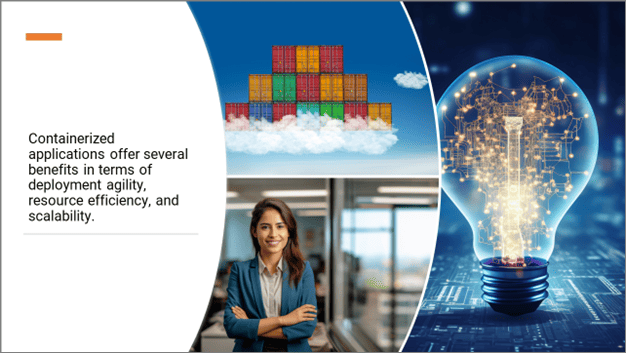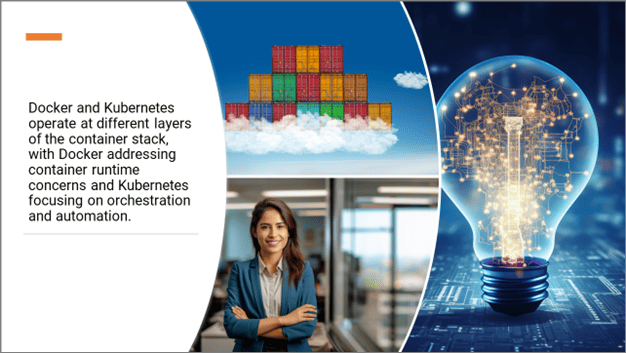Docker vs. Kubernetes: Understanding Containerized Applications and Orchestration
In the realm of modern software development and deployment, containers have revolutionized the way applications are built, shipped, and managed. Among the myriad of containerization technologies, Docker and Kubernetes stand out as two prominent players, each serving distinct but complementary roles in the container ecosystem.
At first glance, Docker and Kubernetes might appear to fulfill similar functions, but they address different aspects of the containerization process. Docker is primarily a platform for creating, distributing, and running containers, while Kubernetes is a powerful orchestration tool designed to automate the deployment, scaling, and management of containerized applications.
What is a Container?
In software development, a container is a lightweight, standalone, executable package that includes everything needed to run a piece of software, including the code, runtime, system tools, system libraries, and settings. Containers encapsulate software dependencies and allow applications to run consistently across different computing environments, such as development laptops, testing environments, and production servers.
Containers are similar to virtual machines (VMs) but operate at a higher level of abstraction. While VMs virtualize hardware, allowing multiple operating systems to run on a single physical machine, containers virtualize the operating system, allowing multiple isolated user space instances to run on a single operating system kernel.
Containers offer several advantages in software development and deployment:
Portability: Containers can run consistently across different environments, eliminating the “it works on my machine” problem. Developers can package their applications along with dependencies and configurations, ensuring consistent behavior across development, testing, and production environments.
Efficiency: Containers are lightweight and share the host operating system’s kernel, which reduces overhead and resource consumption compared to VMs. Multiple containers can run on the same hardware without conflicts, making more efficient use of computing resources.
Isolation: Containers provide process and filesystem isolation, ensuring that applications running in one container do not interfere with applications running in other containers on the same host. This isolation improves security and stability by containing potential issues within the container boundaries.
Scalability: Containers are well-suited for microservices architectures and cloud-native applications. They enable rapid scaling and deployment of individual components, allowing developers to deploy and manage applications more easily in dynamic and distributed environments.
Popular containerization platforms include Docker, which popularized the concept of containers, and Kubernetes, which is a container orchestration platform for managing containerized applications across a cluster of machines.
What is a Containerized Application?
A containerized application refers to a software application that has been packaged and deployed using containerization technology. Containerization involves encapsulating the application and all its dependencies, such as libraries, binaries, and configuration files, into a single executable unit called a container.
Containerized applications leverage containerization platforms like Docker to create, deploy, and manage containers. Docker, for instance, uses container images as templates for containers. These images contain the application code, runtime environment, system libraries, and other dependencies required to run the application.
Overall, containerized applications offer several benefits in terms of deployment agility, resource efficiency, and scalability, making them increasingly popular in modern software development and deployment workflows.
What is Container Orchestration?
Container orchestration is the automated process of managing, deploying, scaling, and maintaining containerized applications. It involves coordinating the deployment and operation of containers across a cluster of hosts to ensure that applications run efficiently, reliably, and at scale. Container orchestration platforms, such as Kubernetes, eliminate the complexities of managing individual containers and provide a centralized control plane for orchestrating containerized workloads.
Key aspects of container orchestration include:
Deployment Automation: Container orchestration platforms enable the automated deployment of containerized applications across a cluster of compute nodes. Users specify the desired state of their applications using declarative configuration files, and the orchestration platform ensures that the actual state matches the desired state.
Scaling: Container orchestration platforms facilitate horizontal scaling of applications by dynamically adjusting the number of container instances based on factors such as resource utilization, traffic load, and application demand. This ensures that applications can scale up or down seamlessly to accommodate changing workloads.
Load Balancing and Service Discovery: Container orchestration platforms provide built-in mechanisms for load balancing and service discovery, ensuring that traffic is distributed evenly across container instances and that services can discover and communicate with each other within the cluster.
Self-Healing: Container orchestration platforms monitor the health and status of containerized applications and automatically take corrective actions in response to failures or issues. This includes automatically restarting failed containers, rescheduling containers to healthy nodes, and performing rolling updates to minimize downtime.
Resource Management: Container orchestration platforms optimize resource utilization by efficiently scheduling containers onto available compute nodes based on resource requirements, affinity/anti-affinity rules, and other constraints. This helps maximize resource utilization and minimize wastage.
Security and Compliance: Container orchestration platforms provide features and mechanisms for securing containerized workloads, managing access control, enforcing network policies, and ensuring compliance with regulatory requirements. This includes features such as role-based access control (RBAC), network segmentation, and container image scanning.
Observability and Monitoring: Container orchestration platforms offer tools and integrations for monitoring the performance, health, and availability of containerized applications and infrastructure. This includes metrics collection, logging, tracing, and alerting capabilities to help operators diagnose and troubleshoot issues proactively.
Overall, container orchestration plays a critical role in modern cloud-native computing environments by enabling organizations to deploy, manage, and scale containerized applications efficiently and reliably. By abstracting away the complexities of container management and providing a unified platform for orchestration, container orchestration platforms empower developers and operators to focus on building and delivering software without being burdened by infrastructure concerns.
Understanding Docker
Docker emerged as a game-changer in the world of software development, offering a standardized format to package applications and their dependencies into lightweight, portable containers. With Docker, developers can encapsulate their applications along with all necessary libraries and dependencies, ensuring consistency and reproducibility across different environments.
The core components of Docker include:
Docker Engine: The runtime environment responsible for creating and executing containers.
Docker Images: Immutable snapshots that contain everything needed to run an application, including code, runtime, libraries, and dependencies.
Dockerfile: A text file that defines the configuration and steps required to build a Docker image.
Docker Registry: A repository for storing and sharing Docker images, with Docker Hub being the most popular public registry.
Docker’s simplicity and ease of use have made it a favorite among developers for local development and testing. However, as applications scale and become more complex, managing individual containers manually becomes cumbersome and inefficient. This is where Kubernetes comes into play.
Understanding Kubernetes
Kubernetes, often abbreviated as K8s, was originally developed by Google and later open-sourced under the Cloud Native Computing Foundation (CNCF). It builds upon the concepts of containerization pioneered by Docker and provides a robust framework for automating the deployment, scaling, and operation of application containers across clusters of hosts.
Key features of Kubernetes include:
Container Orchestration: Kubernetes automates the deployment, scaling, and management of containerized applications, ensuring high availability and resource efficiency.
Service Discovery and Load Balancing: Kubernetes provides built-in mechanisms for service discovery and load balancing, enabling seamless communication between microservices.
Self-healing: Kubernetes continuously monitors the health of applications and automatically restarts or reschedules containers in case of failures.
Horizontal Scaling: Kubernetes enables horizontal scaling of applications by dynamically adjusting the number of replicas based on resource utilization and demand.
One of the defining features of Kubernetes is its declarative configuration model, where users describe the desired state of their applications using YAML or JSON manifests. Kubernetes then reconciles the actual state with the desired state, ensuring that the application environment remains consistent and resilient.
Docker vs. Kubernetes: Clarifying the Confusion
Despite their complementary roles, the distinction between Docker and Kubernetes is often misunderstood, leading to confusion among developers. To clarify:
Docker is a Containerization Platform
Docker provides tools and APIs for building, packaging, and running containers on individual hosts. It focuses on the creation and management of container images, as well as the execution of containers using the Docker Engine.
Kubernetes is a Container Orchestration Platform
Kubernetes, on the other hand, is a container orchestration platform that automates the deployment, scaling, and management of containerized applications across clusters of hosts. It abstracts away the underlying infrastructure and provides a unified API for managing applications at scale.
In essence, Docker and Kubernetes operate at different layers of the container stack, with Docker addressing container runtime concerns and Kubernetes focusing on orchestration and automation.
Choosing the Right Tool for the Job
The decision to use Docker, Kubernetes, or both depends on the specific requirements and constraints of your application and infrastructure. Here are some considerations to keep in mind:
Application Complexity: For simple applications with few dependencies and modest scaling requirements, Docker alone may suffice. However, as applications grow in complexity and scale, Kubernetes becomes indispensable for managing deployment and orchestration challenges.
Scalability and High Availability: Kubernetes excels in managing large-scale, distributed applications that require automatic scaling, load balancing, and self-healing capabilities. If your application needs to scale dynamically in response to varying workloads, Kubernetes is the preferred choice.
Resource Constraints: Docker is lightweight and well-suited for resource-constrained environments such as development laptops or single-node deployments. Kubernetes, while more resource-intensive, offers unparalleled scalability and resilience for production-grade deployments.
Ecosystem and Community Support: Both Docker and Kubernetes boast vibrant ecosystems and extensive community support. Docker Hub provides a vast repository of pre-built images, while Kubernetes benefits from a rich ecosystem of tools, plugins, and integrations developed by contributors and vendors alike.
i3solutions: The Docker and Kubernetes Experts
As you navigate the complexities of technologies like Docker and Kubernetes, expert guidance and collaboration become invaluable. i3solutions brings a wealth of experience and expertise to the table, offering insights that span architecture design, deployment strategies, and optimization techniques. With our assistance, businesses can effectively leverage containerization technologies to streamline development workflows, enhance scalability, and improve resource utilization. From conceptualization to implementation, i3solutions serves as a trusted ally, helping organizations harness the full potential of Docker and Kubernetes while addressing unique challenges along the way. By partnering with i3solutions, businesses can confidently embark on their containerization journey, empowered to unlock new levels of agility and efficiency in their software development lifecycle. Reach out to i3solutions to discuss your software development initiatives.
Leave a Comment




